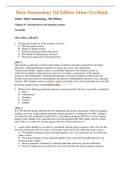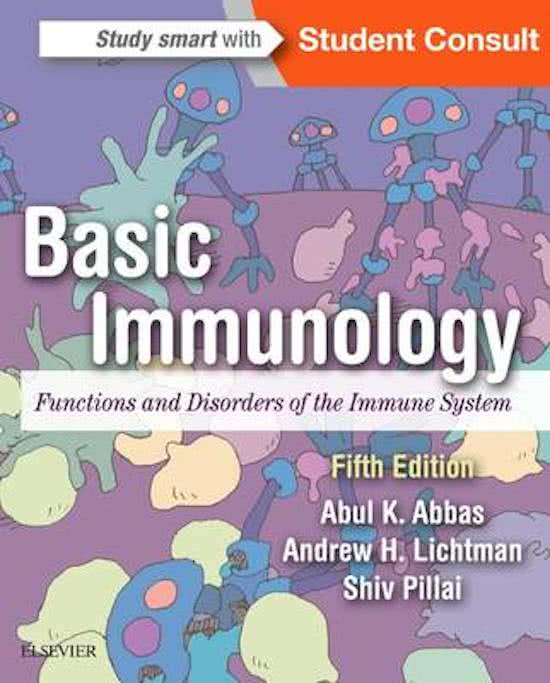Basic Immunology 5th Edition Abbas Test Bank Abbas: Basic Immunology, 5th Edition Chapter 01: Introduction to the Immune System Test Bank MULTIPLE CHOICE 1. The principal function of the immune system is: A. Defense against cancer B. Repair of injured tissues C. Defense against microbial infections D. Prevention of inflammatory diseases E. Protection against environmental toxins ANS: C The immune system has evolved in the setting of selective pressures imposed by microbial infections. Although immune responses to cancer may occur, the concept that “immunosurveillance” against cancer is a principal function of the immune system is controversial. Repair of injured tissues may be a secondary consequence of the immune responses and inflammation. Although the immune sys tem has regulatory features that are needed to prevent excessive inflammation, prevention of inflammatory diseases is not a primary function. The immune system can protect against microbial toxins, but it generally does not offer protection against toxins of nonbio lNogUicRoSriIgiNn.GTB.COM 2. Which of the following infectious diseases was prevented by the first successful vaccination? A. Polio B. Tuberculosis C. Smallpox D. Tetanus E. Rubella ANS: C In 1798, Edward Jenner reported the first intentional successful vaccination, which was against smallpox in a boy, using material from the cowpox pustules of a milkmaid. In 1980, smallpox was reported to be eradicated worldwide by a vaccination program. Effective vaccines against tetanus toxin, rubella virus, and poliovirus were developed in the 20th century and are widely used. There is no effective vaccine against Mycobacterium tuberculosis. 3. A previously healthy 8-year-old boy is infected with an upper respiratory tract virus for the first time. During the first few hours of infection, which one of the following events occurs? A. The adaptive immune system responds rapidly to the virus and keeps the viral infection under control. B. The innate immune system responds rapidly to the viral infection and keeps the viral infection under control. C. Passive immunity mediated by maternal antibodies limits the spread of infection. D. B and T lymphocytes recognize the virus and stimulate the innate immune response. E. The virus causes malignant transformation of respiratory mucosal epithelial cells, and the malignant cells are recognized by the adaptive immune system. ANS: B The innate immune response to microbes develops within hours of infection, well before the adaptive immune response. B and T lymphocytes are components of the adaptive immune response, and they would not be able to respond to a newly encountered virus befo re the innate immune response. An 8 -year-old boy would no longer have maternal antibodies from transplacental passive transfer and is unlikely to be breast -feeding, which is another potential source of maternal antibodies. Malignant transformation takes months or years to develop. 4. Which of the following is a unique property of the adaptive immune system? A. Highly diverse repertoire of specificities for antigens B. Self-nonself discrimination C. Recognition of microbial structures by both cell-associated and soluble receptors D. Protection against viral infections E. Responses that have the same kinetics and magnitude on repeated exposure to the same microbe ANS: A Highly diverse repertoires of specificities for antigens are found only in T and B lymphocytes, which are the central cellular components of the adaptive immune system. Both the innate and the adaptive immune systems use cell -associated and soluble receptors to recognize microbes, display some degree of self -nonself discrimination, and protect against viruses. On repeated exposure to the same mi crobe, the aNdUapRtiSveIimNGmTunBe.reCspOoMnse becomes mo re rapid and of greater magnitude; this is the manifestation of memory. 5. Antibodies and T lymphocytes are the respective mediators of which two types of immunity? A. Innate and adaptive B. Passive and active C. Specific and nonspecific D. Humoral and cell-mediated E. Adult and neonatal ANS: D Both B and T lymphocytes are principal components of adaptive immunity. B lymphocytes produce antibodies, which are the recognition and effector molecules of humoral immune responses to extracellular pathogens. T cells recognize and promote eradication of intracellular pathogens in cell -mediated immunity. Passive and active immunity both can be mediated by either B or T lymphocytes. Specific immunity is another term for adaptive immunity. Both B and T lymphocytes participate in adult adaptive immunity but a re still developing in the neonatal period. 6. A standard treatment of animal bite victims, when there is a possibility that the animal was infected with the rabies virus, is administration of human immunoglobulin preparations containing anti –rabies virus antibodies. Which type of immunity would be established by this treatment? A. Active humoral immunity B. Passive humoral immunity C. Active cell-mediated immunity D. Passive cell-mediated immunity E. Innate immunity ANS: B Humoral immunity is mediated by antibodies. The transfer of protective antibodies made by one or more individuals into another individual is a form of passive humoral immunity. Active immunity to an infection develops when an individual’s own immune system responds to the microbe. Cell -mediated immunity is mediated by T lymphocytes, not antibodies, and innate immunity is not mediated by either antibodies or T lymphocytes. 7. At 15 months of age, a child received a measles -mumps -rubella vaccine (MMR). At age 22, she is living with a family in Mexico that has not been vaccinated and she is exposed to measles. Despite the exposure, she does not become infected. Which of the following properties of the adaptive immune system is best illustrated by this scenario? A. Specificity B. Diversity C. Specialization D. Memory E. Nonreactivity to self ANS: D Protection against infection s after vaccination is due to immunologic memory of the adaptive immune system. Memory is manifeNstUedRaSs Ia mNGorTe Bra.piCdlOy Mdeveloping and vigorous response on repeat exposure to an antigen compared with the first exposure. Specificity and diversity are properties related to the range of antigenic structures recognized by the immune system, and specialization is the ability of the adaptive immune system to use distinct effector mechanisms for distinct infections. 8. A vaccine administered in the autumn of one year may protect against the prevalent strain of influenza virus that originated in Hong Kong that same year, but it will not protect against another strain of influenza virus that originated in Russia. This phenomenon ill ustrates which property of the adaptive immune system? A. Specificity B. Amnesia C. Specialization D. Cultural diversity E. Self-tolerance ANS: A Adaptive immune responses are highly specific for distinct molecular structures, which may be present in a vaccine and be pr oduced by one strain of virus but not by a closely related strain. Amnesia, although generally not used in immunology, implies lack of memory, but the efficacy of the vaccine against the Hong Kong strain implies it has induced memory. The same effector mechanisms would be required to combat different strains of influenza, and therefore failure of a vaccine to protect against two different strains of virus is not related to specialization of effector functions. 9. The two major functional classes of effector T lymphocytes are: A. Helper T lymphocytes and cytotoxic T lymphocytes B. Natural killer cells and cytotoxic T lymphocytes C. Memory T cells and effector T cells D. Helper cells and antigen -presenting cells E. Cytotoxic T lymphocytes and target cells ANS: A T cells can be classified into effector subsets that perform different effector functions. Most effector T cells are either helper T lymphocytes, which promote macrophage and B cell responses to infections, or cytotoxic T lymphocytes, which directly kill i nfected cells. Natural killer cells are not T lymphocytes. Antigen -presenting cells usually are not T cells. Memory T cells are not effector T cells. 10. Which of the following cell types is required for all humoral immune responses? A. Natural killer cells B. Dendritic cells C. Cytolytic T lymphocytes D. B lymphocytes E. Helper T lymphocytes ANS: D Humoral immune responses are antibody -mediated immune responses, and all antibodies are made by B lympho cytes and by no NotUheRr SceIllNtyGpTe.B.COM 11. During a humoral immune response to a newly encountered bacterial infection, B cells are first stimulated to proliferate and then secrete antibodies specific for the bacterium. The antibodies may then bind to the bacteria and facilitate ingestion of the mi crobes by phagocytic cells. In what phase of the humoral immune response does the binding of secreted antibodies to bacteria occur? A. Recognition phase B. Activation phase C. Effector phase D. Homeostatic phase E. Memory phase ANS: C The effector phase of an immune response occurs when cells or molecules eliminate the microbe or microbial toxin. In a humoral immune response, the effector phase includes secretion of antibody, binding of the antibody to the microbe or toxin, and subseque nt antibody -dependent elimination of the microbe or toxin. The recognition phase is the initial binding of the antigen by the naive lymphocyte. The activation phase includes proliferation and differentiation of lymphocytes in response to antigen recognitio n. The homeostatic phase follows the effector phase, during which the response wanes. In the memory phase, memory B cells and antibodies secreted by long -lived antibody -secreting cells are “waiting” for a repeat exposure to the microbe.





